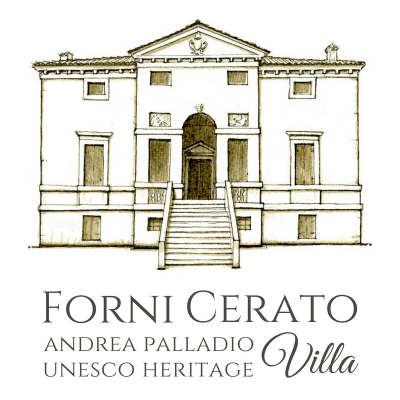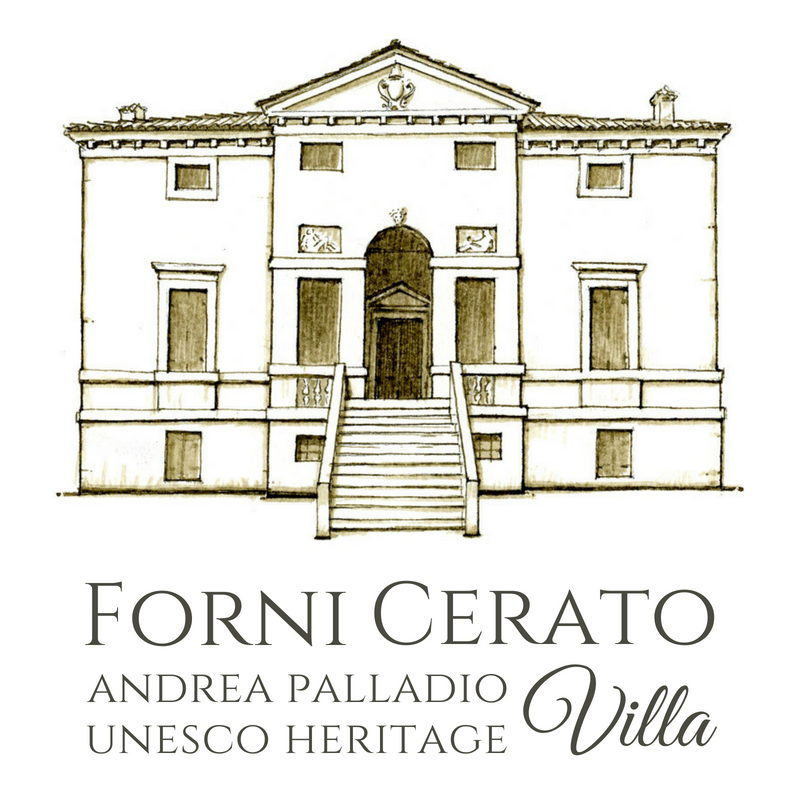Villa Forni Cerato
Villa Forni Cerato, whose design is attributed to the great architect Andrea Palladio,
is a Villa located in Veneto region, in Montecchio Precalcino.
The building has been included in the UNESCO World Heritage List since 1996.
Since 2018, the Monument and the whole complex have been object of a conservative restoration that intends to restore the building to its 16th-century splendor and prevent it from being neglected, as unfortunately happened in the past. Villa Forni Cerato re-opens to the public from September 8th, 2023 on the occasion of the institution, of the ” The Little Academy of Restoration,” by Villa Forni Cerato Foundation. The aim of the project is to let visitors discover what are the problems and the possible solutions in the restoration of a protected historical property, starting from the historical research on the life of the villa and the absence of any kind of re-functionalization.
Official Note
The Manifesto
The Monumental Villa will always be just a World Heritage Site. As owners, we will never allow any transformation or reuse and we will devote it special attention in respect of its history. From now on, we will secure the parapets of the external staircase, the wall paintings of the loggia exposed to the weather, the roof, the holes in the floors. Meanwhile, the best experts in the field will prepare a general plan of extraordinary maintenance of the good, to be approved by SABAP, aimed to safeguard every fragment of the original thought of Andrea Palladio. It will be possible to discover all the secrets that Villa Forni Cerato hides. It will remain without fixed electric lighting, without heating or air conditioning, without running water, bathrooms or anything else that has not been present in its history: all this can find place in the adjacent building “barchessa”, which must be restored as soon as possible. We know that this patronage is unusual, because we want the important work of preserving the property, which we do not define restoration, to be:
SHY, with maximum respect for every still existing detail
PERENNIAL, planning and financing future maintenance work, so that it is no longer neglected
PARTICIPATORY, made with the joint contribution of many experts who are Palladio lovers
EXEMPLARY, but the others will judge, surely not us.
Villa Forni Cerato is reborn to become a protected and “holy” place for those who love Palladio, a cultural site and meeting place to study and discuss architecture, art, restoration, conservation, history, especially of Palladio.
It is located in Montecchio Precalcino in the province of Vicenza: here schools and universities from all over the world will be welcome, here young people will study a masterpiece of the Vicenza Renaissance, sculptures by Alessandro Vittoria, the places of the history of Girolamo Forni, above all, they’ll look at Palladio.
Ivo Boscardin – President of Villa Forni Cerato Foundation – 09.03.2020
Official Note
Restoration Work
Villa Forni Cerato Foundation is a guarantor of the Manifesto of March 9, 2020, published on the official website to protect Villa Forni Cerato World Heritage Monument.
The conservative restoration choices adopted are:
CONSERVATION OF THE LANDMARK: the conservation of a historic building must be based on adequate knowledge of its structural and construction characteristics, of their evolution and transformation over time, of the processes of alteration or deterioration of its components. The first and priority objective is to stop all forms of ongoing degradation that could compromise the future life of the property. The intervention must also have the aim of avoiding or in any case postponing as much as possible the manifestation of the deterioration on which the intervention has been made. These interventions are in line with the SHY restoration requested by the Manifesto. The only objective is to keep the Monument intact over time, protect it from bad weather and guarantee the safety of the visitor.
RESTORATION OF THE ORIGINAL CONDITIONS OF THE WORK: where possible, without traumatic interventions for the work or which could compromise its correct conservation, the restoration aims to restore the object of intervention to its original appearance, freeing it from transformations that make the work difficult to read the stylistic intent that characterizes it. The restoration must be carefully weighed and evaluated also on the basis of the importance and documentary and historical value of what is intended to be removed. These interventions are bringing to light important original architectural elements of Palladio’s work, aiming to re-establish the potential unity of the work of art, that is, the work of Andrea Palladio. We know that future research may suggest different choices from the current ones, and it is certain that they will always have to be widely documented and discussed in the working group, so that the restoration is PARTICIPATORY, the work of several experts and not of a single person, like a scientific experiment, certifiable and repeatable. The cognitive elements, critical reflections and experiences accumulated during the work program must be considered the heritage of anyone who cultivates similar interests.
POSSIBLE USE OF RESPECTFUL AND CONSISTENT INTEGRATIVE INTERVENTIONS, if made necessary by the conservation of the asset or by the search for the recomposition of the unified interpretation of the same. The coherence must be both stylistic and material, and the additions must be distinguishable and reversible. An exemplary conservation work must prevent and constantly monitor the Monument over time, i.e. be NEVER ENDING. Within a dialectic inspired by doubt and therefore by the critical comparison of the different options, we must always be aware that, when faced with a conservation problem, it is necessary to position ourselves in a non-prejudicial or dogmatic way, avoiding the superposition of theoretical propositions on a constantly changing reality and therefore never fit into pre-established typologies.
Precisely from the delicacy of this artefact and from the awareness that there was a duty to pass on its existence, the feeling of respect, attention and care that guides the design and restoration work of the Villa originated. It is therefore precisely from the existence of such deplorable conditions of abandonment that, almost paradoxically, the will to conserve and enhance this extraordinary building at all costs has been built with increasing determination.
Ivo Boscardin – President of Villa Forni Cerato Foundation – 09.03.2023







